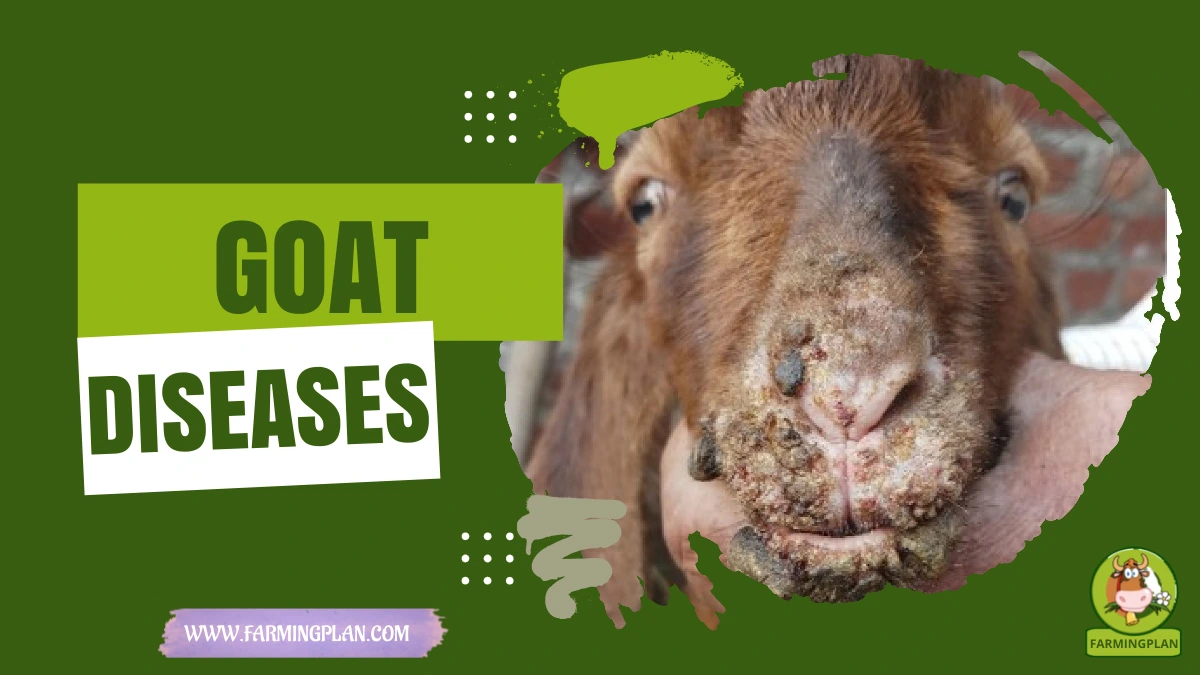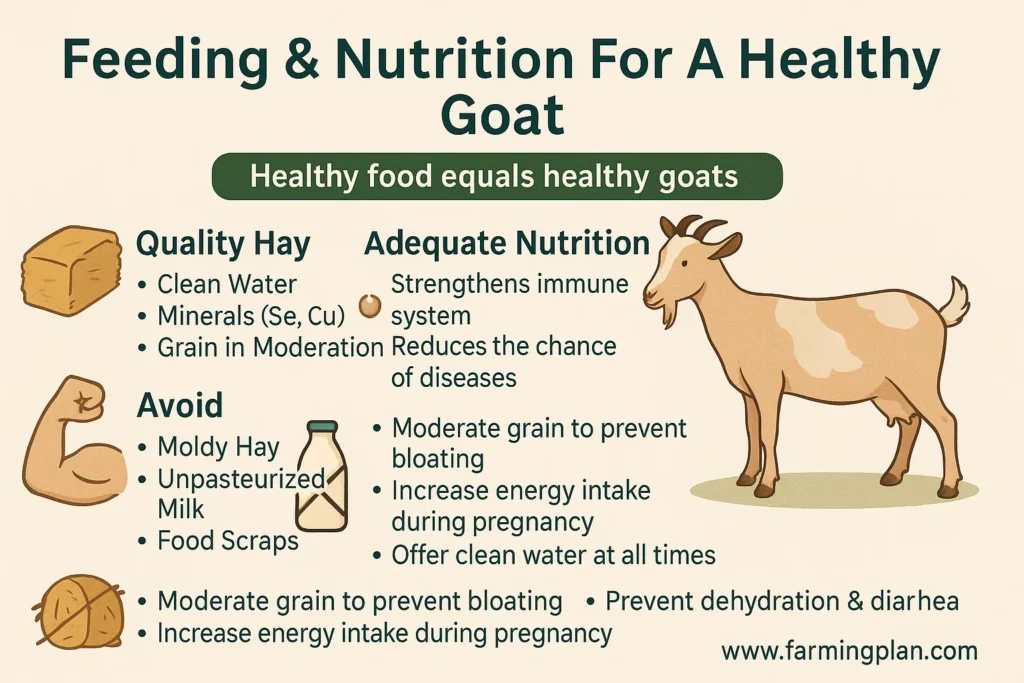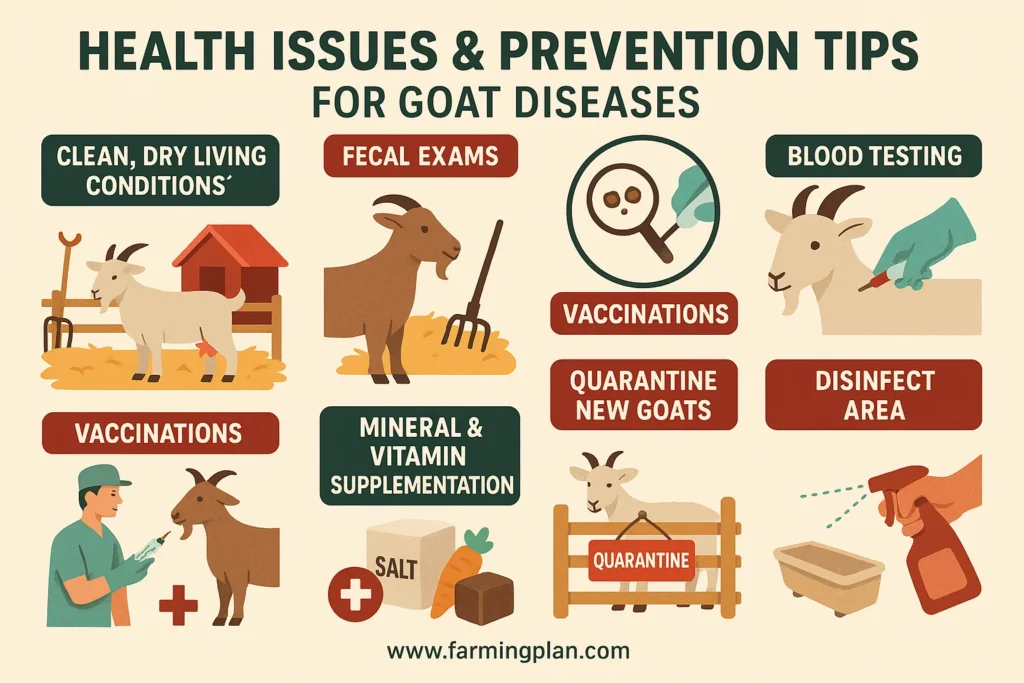If you’ve ever raised goats, you know how quickly things can go from calm to chaos when one gets sick. As a farming specialist who’s seen almost every goat ailment you can think of, I’ve learned the hard way that early signs and quick action can save not just one goat—but sometimes your entire herd. In this guide, I’ll walk you through the most common goat diseases, their symptoms, treatments, and how to stop them before they start. From diarrhea and hoof rot to pink eye and mastitis, we’ll cover what you need to know to keep your goats happy, healthy, and productive.

History & Origin Of Goat Diseases
Diseases in goats have existed for as long as goats themselves. Early farmers from thousands of years ago noticed health problems among their animals long before modern medicine existed. Back then, people relied on natural remedies and sharp observation. They learned to recognize when a goat wasn’t chewing cud, isolating itself, or walking funny—all signs something was off.
Over time, as goat farming spread across different regions, so did a variety of goat ailments. Warmer climates led to more parasitic infections, while colder, wetter areas saw more hoof issues. With the growth of dairy goat herds and meat production in places like the U.S., India, and Africa, diseases like coccidiosis, CAE (caprine arthritis encephalitis), and mastitis have become more common and well-documented.

Today, we have resources like the Merck Veterinary Manual and MSD Veterinary Manual to guide us, but history still teaches us one thing: goat diseases are nothing new, but smart herd management has always been the key to keeping them under control. By understanding the history and origin of goat diseases, you can take control of your herd’s health and prevent potential outbreaks.
Reads More: Amazing Miniature Horse Care: Your Ultimate Friendly Guide
Key Characteristics Of Goat Diseases
For instance, coccidiosis, a common parasitic disease, often presents with watery diarrhea and weight loss. On the other hand, caseous lymphadenitis (CL) is characterized by abscesses near lymph nodes. Understanding these key characteristics can help you identify potential health issues in your goats.
Some issues like coccidiosis hit young goats hard, especially during stressful events like weaning. You’ll see watery diarrhea, weight loss, and sometimes blood in the stool. Others, like caseous lymphadenitis (CL), show up as abscesses near lymph nodes and can hang silently in your herd if you’re not careful.
Then there are metabolic disorders like pregnancy toxemia in does or selenium deficiency in kids, which are linked to diet and pregnancy. Some diseases are bacterial, like mastitis and pneumonia, while others are viral or parasitic. Each one comes with its own warning signs, treatment plan, and risks—not just to goats but sometimes to humans, too.
Temperament Changes From Goat Diseases
When a goat gets sick, it doesn’t always show it right away with physical symptoms. The first sign might be in its mood. A typically playful or curious goat might act withdrawn, grumpy, or sluggish. I’ve learned to pay attention when my goats aren’t their usual busy selves. Sick goats might isolate themselves from the herd or avoid feeding time. Some become aggressive or vocal, especially if they’re in pain.
A goat with mastitis might flinch when her udder is touched. One with hoof rot might limp or refuse to walk. Behavior tells a big part of the story. Once you understand each goat’s personality, changes in temperament can clue you in before the disease gets worse. Catching those signs early can save you a lot of vet bills—and maybe even a life.
Feeding & Nutrition For A Healthy Goat Diseases
Nutrition plays a massive role in keeping goat diseases at bay. I always say that healthy food equals healthy goats. A well-balanced diet strengthens their immune system and reduces the chance of infections and deficiencies.

Goats need quality hay, clean water, minerals (especially selenium and copper), and grain in moderation. Lack of essential nutrients can cause conditions like white muscle disease, which affects the skeletal muscles in young kids. Overfeeding grain can lead to bloating or acidosis.
Avoid feeding moldy hay, unpasteurized milk, or food scraps that aren’t meant for goats. During pregnancy, increase energy intake for does to prevent pregnancy toxemia. And always offer clean water—dehydration makes diarrhea worse, especially in cases of coccidiosis or other intestinal infections.
Common Purposes for Goat Diseases
Goats are incredibly versatile animals, which is one reason I love working with them. Whether you’re raising goats for milk, meat, fiber, or even just as pets, they bring a lot to the table. Dairy goats provide fresh milk that can be turned into cheese or yogurt, but they’re also vulnerable to diseases like mastitis, which can seriously cut down milk production if left unchecked. Meat goats need strong parasite control because intestinal worms and other parasites can cause weight loss and poor growth, affecting your profits and herd health.
Fiber goats, like Angoras, need special attention to their skin and coat since they’re more prone to skin infections and external parasites that can damage their valuable fleece. Even if you keep goats as pets or for land clearing, they aren’t immune to common goat diseases. Orf disease, for instance, is a contagious viral infection that can jump from goats to humans, causing painful sores. Each purpose calls for specific care strategies—from diet to housing and health management. When you understand why you’re raising goats, you can tailor your routine to prevent common health problems and keep your herd thriving.
Special Features of Goat Diseases
Some goat diseases have very distinctive signs, which helps me spot trouble early. Take orf disease, also known as contagious ecthyma—it causes crusty, scabby sores mainly around the goat’s mouth and nose. Because orf is zoonotic, meaning it can spread to humans, I always use gloves and protective clothing when handling infected animals. Another tricky one is CAE (caprine arthritis encephalitis), a viral disease that often causes swollen joints and stiffness in adult goats, while young kids may suffer from nervous system problems like encephalitis.
Coccidiosis is a parasite-related disease that mainly hits young goats, causing nasty diarrhea—usually after stressful events like weaning or moving. Johne’s disease is another sneaky illness that shows up as slow, chronic weight loss and digestive problems but is hard to catch early without lab tests. Hoof rot, easily identified by a foul smell and peeling hoof walls, can cripple a goat’s mobility if not treated promptly. Knowing these distinct features means I can act quickly, whether that’s isolating the sick goat, starting treatment, or calling my vet for a precise diagnosis.
Health Issues & Prevention Tips for Goat Diseases
Goat diseases might seem overwhelming, but the good news is most can be prevented with good herd management. I always stress the importance of clean, dry living conditions. Wet and muddy pens are the perfect playground for bacteria and parasites, so regular cleaning and fresh bedding make a huge difference. I schedule routine fecal exams to catch internal parasites before they cause severe damage. For more stubborn diseases like CAE or Johne’s, blood testing helps detect infection early, allowing me to manage the herd before it spreads.

Vaccinations are a must—skipping them leaves your goats vulnerable to diseases that can devastate a herd. I also make sure my goats get enough minerals and vitamins, as deficiencies can weaken their immune system and open the door to infections. New goats always spend time in quarantine to make sure they don’t bring in new germs. And if a goat does get sick, I separate it immediately, disinfect the area, and double-check my entire herd’s health history for warning signs. With these proactive steps, I keep my goats healthy and productive, which makes my job a whole lot easier—and more enjoyable.
Reads More: Jersey Cattle: Incredible Milk Producers You’ll Love
Step-by-Step Goat Health Care Guide
Step 1: Set Up A Clean, Dry Shelter
Start with the basics. A dry, doesn’tree shelterIt’stects your goats from the elements and keeps infections like pneumonia at bay. I keep bedding fresh and make sure manure doesn’t build up. It’s also where I isolate sick animals if needed.
Step 2: Maintain A Daily Routine
Goats thrive on routine. Feed them at the same time every day, offer fresh water, and observe each one closely. I watch for changes in behavior, weight, and appetite—these often come before any physical symptoms.
Step 3: Perform Monthly Health Checks
Every month, I check hooves, gums, eyes, and coat condition. I trim hooves to avoid rot and look for signs of lice or mites. I also do a basic physical examination—feeling for abscesses or swelling.
Step 4: Use Preventive Treatments
I follow a seasonal deworming schedule based on fecal tests. For coccidiosis, I use medicated feed or give treatments like sulfa drugs if symptoms appear. Selenium injections help prevent white muscle disease in areas with deficient soil.
Step 5: Keep Records
Write everything down. Track illnesses, medications, vaccinations, breeding, and weight changes. If you ever need to talk to a vet, having your herd health history makes diagnosis and treatment faster and more effective.
“Healthy Goats Don’t Just Happen—They’re Built With Daily Care, Sharp Eyes, And A Whole Lot Of Patience!”
Exgoat’sips & Best Practices
From my years of working with goats, I can confidently say that prevention beats treatment every time. Keeping your goat’s environment clean is the first and most crucial step—dirty pens and damp bedding are a recipe for infections and parasites. I always make sure to clgoat’st stalls regularly and provide fresh, dry bedding to keep harmful bacteria and fungi at bay.
Stress is another significant factor that weakens a goat’s immune system. Changes like moving to a new pen, weather extremes, or overcrowding can make goats more vulnerable to diseases. It’s important to maintain a calm and consistent routine for my herd and avoid sudden disruptions whenever possible. Plus, when bringing new goats home, it’s vital to quarantine them for at least two weeks to prevent any hidden infections from spreading. I also recommend isolating any sidon’timals immediately to minimize contact with healthy goats.
When dealing with contagious diseases like caseous lymphadenitis (CL) or ORF, I don’t take chances—I always wear protective gloves and wash up thoroughly afterward. These diseases can spread to humans, so safety first! Vaccinations are another cornerstone of prevention. Don’t skip them, even if your goats look healthy. Some illnesses can lurk under the surface, and visual checks alone won’t catch them early. Lastly, never underestimate the power of good nutrition—it builds a strong immune system and keeps your goats fighting fit. If you ever feel uncertain about a symptom or treatment, consult a trusted vet or reliable resources like the Merck Veterinary Manual. Remember, early questions and intervention save lives and money.
Where To Buy Healthy Goats & Medications
Finding healthy goats starts witherd’ssing the right source. I always recommend reputable breeders who provide full health records and are not transparent about their herd’s history. This way, you know exactly what you’re getting and can avoid bringing in animals carrying diseases you didn’t anticipate. Crowded auctions or markets can be risky since herhaven’th is often unknown and animals from multiple sources mingle there. If possible, seek out breeders with closed herds—meaning their goats haven’t had contact with outside animals. This greatly reduces the chance of infections sneaking in.
When it comes to medications and treatments, your best bet is to work with licensed veterinary suppliers or clinics. While some feed stores stock common dewormers and coccidiosis treatments, serious dherd’ss often require prescriptioyou’recations and professional guidance to treat properly. A vet can also help tailor treatment plans to your herd’s specific needs and ensure you’re using medicines safely and effectively. Always avoid self-medicating without proper knowledge, as this can do more harm than good. Having reliable sources for both healthy goats and medicines lays the foundation for a strong, thriving herd.
FAQs
What is the most common goat disease?
Coccidiosis is one of the most common, especially in young goats. It causes diarrhea and weight loss.
How do I treat diarrhea in goats?
Start with electrolytes and isolate the goat. Use medications like sulfa drugs if coccidia is suspected.
Can humans get sick from goat diseases?
Yes, some diseases like orf and Q fever can transfer from goats to humans. Always wear gloves when handling sick goats.
How do I prevent hoof rot in goats?
Keep living areas dry, trim hooves regularly, and use foot baths with zinc sulfate if needed.
What causes mastitis in goats?
Bacterial infections, usuallythey’reoor hygiene or injuriI’veo the udder, are the main cause.
Conclusion
Goat diseases caI’veel overwhelming, but with the right knowledge, they’re totally manageable. I’ve dealt with jusyou’ret every issue mentioned here, and what I’ve learned is this: stay observant, act fast, and keep your goats on a healthy routine. Whether you’re raising them for milk, meat, or love, you’ll depend on you to keep them safe, strong, and smiling (well, as close as a goat gets to smiling). Stick to the tips in this guide, and you’ll have a happy, healthy herd in no time.
